A new one for me in the review stakes. Despite having owned Lanikai ukes, and having regularly recommended them, I found I had not actually reviewed one. Therefore was delighted when Leon from Lanikai got in touch asking me to take a look at this new development. The LUTU-21C TunaUke.
I have a lot of respect for Lanikai in many ways. They don't purport to make the worlds best ukuleles, but they do make some fine and reliable beginner instruments. They also do a lot of work in pushing boundaries and developing new ideas, such as their USB instrument. In this case, Lanikai have focussed on one gripe that many beginners have with cheaper instruments, and that is poor intonation (the accuracy of the instrument when tuned). These problems are often caused by a poor setup or a badly placed saddle and Lanikai have developed a whole new bridge concept that allows complete adjustment of the saddle for each individual string. In theory this means that, with adjustment, you can reach tuning nirvana! Let's take a look.
The TunaUke is based on their standard LU21 series of ukes that come in soprano, concert and tenor flavours, and is essentially the same as the standard LU21C uke apart from the bridge system. I have found the TunaUke on line from anywhere between $100 and $120, whereas the stock LU21C can be found from $80 to $100. You are therefore paying a slight premium for this system.
As such you get a laminate mahogany finished body (no solid woods here), and few other embellishments apart from some cream edge binding where the top and back meet the sides. It is plain looking, in a deep brown, but like other LU21 ukes I have played or owned, has a very nice solid and tactile feel to it. This one is extremely tidily put together with no marks or issues with the bindings.
The top is one piece, as are the sides and the back, and all have a straight regular grain pattern that runs in parallel with the uke. We have no other decoration and the sound hole is unadorned. Simple to look at but pleasing is my view. That back is dead flat with no arch at all.
But that new bridge system really stands out. What we have is a rosewood bridge mounting, and within is a plastic insert where a standard saddle would sit. The insert comprises four separate slots into which individually shaped saddle pieces are fitted. Therefore we have no single saddle, rather a saddle for each string.
The concept is similar to that seen on electric guitars, and allows you to move the saddles back and forth, which either lengthens or shortens the string. An accurate ukulele needs accuracy in the distance between the nut and saddle, and the concept here is that you can set that perfectly. Many people assume that the distance should be the same for each string, but as the strings are different thicknesses, technically they need separate scale lengths. Therefore, to test your accuracy, you tune the uke up, then compare the note played at the 12th fret to the note played when the string is open. They should be exactly the same, just an octave apart. If the note at the 12th fret is slightly flatter in tone, then by moving the saddle toward the nut you shorten the string and try again. Eventually you will get a note at the 12th which is the same as the open note, and your uke is perfectly intonated. Likewise if the note at the 12th is sharp, you move it the other way to lengthen the string. Repeat that for each string and you are done. It's a simple concept and it works. My views on it are further down though.
Moving on from the body we have a very comfortable and tidy mahogany neck, made from three pieces of wood. The rosewood fingerboard is equally tidy and has some nice shaping at the end. The edges of the rosewood are a little sharp, but I wouldn't expect rolled fingerboard edges at this price. The frets are nickel silver and we have 18 in all and 14 to the body. They are dressed very well and comfortable on the fingers.
Fingerboard markers are inlaid in a mother of pearl type material at the 5th, 7th, 10th, 12th and 15th frets, but sadly there are no side fretboard markers for the player. The edges of the fingerboard look to be bound to hide the fret edges, though this may just be a wood stain or paint. Either way though it is a nice touch.
The nut both interests and confuses me. It appears to be made of NuBone or Tusq and is itself cut for intonation. I have not seen nut slots like them before and give a different break point to each individual string. I like the concept, but with the adjustable bridge I wonder why it is needed? That said, with a nut like this and a bridge you could NOT move, you would then face issues if you moved to thicker strings or a low G. Still, interesting to note.
The headstock is a typical Lanikai design, and is unfaced and made from the same neck material. The Lanikai logo is in gold and is applied a sticker rather than an inlay or screen print. I don't personally like it as I believe that consistent use of a clip on tuner may eventually cause the sticker to peel.
Tuning is provided by silver sealed geared tuners with no branding. They work really well though and feel great. The buttons especially I really like. Not only are they sized to compliment the instrument, they are made of a kind of soft touch matte plastic and are really pleasing on the fingers. The kind of material you may expect on the dashboard of a premium car.
The package is completed by Aquila brand strings (what else) a booklet and chord charts showing you how to adjust the bridge and, helpfully, a second spare set of saddle pieces that are higher allowing you to adjust the action up.
So all in all a nice little package, well made and just that little bit different. But how did I get on with it.
Well let us deal with the bridge system first of all. I don't mind admitting that when I first saw these I thought, WHY? A couple of things crossed my mind really. Firstly, why not just make the uke properly and well intonated? Sure, many beginner ukes can be woeful in this department, but is the answer to that creating a system that puts the adjustment in the hands of the player and not the manufacturer?
Secondly, is intonation on a concert scale uke really that much in need of adjustment? My Kanile'a Tenor has a pretty straight bridge saddle but intonates incredibly well and I am often confused at the need for compensated saddles.
Sounds like I am being down on it, right? Well then I thought a little more and things started to make some sense to me.
1. Intonation is an issue for many ukes, and not everybody is buying a hand crafted instrument that you would expect to be perfect. And here is the thing, even with hand crafted uke saddles, they too can often need adjustment. I have adjusted these for scale myself through the use of a bit of very careful sanding at the top of the saddle to adjust the break point of the string. But does a beginner with a budget of $100 really want to go through that? The TunaUke gives them the ability to adjust, and that should be a good thing.
2. When you make a change to a low G string (or to fatter strings) you can throw intonation out if you don't adjust the bridge. This model removes any worries in that regard.
3. What if you are left handed? This allows you to re configure all strings to intonate correctly without getting a saddle reshaped
4. Of course, this will appeal to anyone who is addicted to 'meddling'. If you like fiddling with instruments, you will knock yourselves out with this!
So on the whole, I 'get' the system to some degree, and I would give top marks to Lanikai for working with new ideas. I do have an issue though, and that is with action height. Because of the way the saddles fit in the mounting, it seems to me that you have little option but the two action heights Lanikai allows with the two sets of saddle pieces. Action, I find, is a very personal thing and I cannot see how, for example, you could find a halfway house height between the two saddle sets. Perhaps if Lanikai offered more sets, such as extra low, low, medium, high this could be solved.
But I am nit picking and for a beginner, so long as it plays in tune, without buzzing, they should be happy. Thankfully, this one does just that, and the setup out of the box on mine was pretty much perfect. A little high on action at the higher frets, but nothing crazy. Action at the nut is pretty much perfect as it can be.
The whole uke 'feels' good and solid in the hands. It is not overly heavy, and feels tactile and playable. The neck has a nice profile for my hands, and aside from the slightly sharp wood edges is comfortable and fast to play.
Sound wise, well, being a laminate uke, it is never going to give you a highly complex tone and bags of harmonics, but it has a bold 'uke like' tone to it that is perfectly acceptable. Sustain is a touch on the low side, but that is to be expected for a laminate body such as this, but it is percussive and enjoyable. Picking seems a little sweeter, but again the lack of sustain is noticeable. But for the price I have played a LOT worse, usually ukes made by guitar makers that are totally overbuilt and dead sounding. This one is not, it sounds like a fun percussive uke.
All in all, I think if you are in the market for a uke at this price, Lanikai should always be on your shopping list. Whether you will drop the extra dollars for the new bridge system I am not sure. I think it certainly should give you some peace of mind that you can adjust if you need to on string changes, low G, being left handed etc. However if you play one side by side with a cheaper LU21c and find the standard uke intonates well, do you really need the new system? It certainly doesn't hamper the uke, so I guess it will come down to your own choice. Full marks though for working with new innovations Lanikai.
Scores and video review below!
PROS
Build quality
Tuners
Innovation
CONS
Inability to fine tune action
Price premium over standard
SCORES
Looks - 8
Fit and Finish - 9
Sound - 7.5
Value For Money - 8.5
OVERALL - 8.4 out of 10
To understand my review scoring and see this result in context - visit my review page at
VIDEO REVIEW
( DIRECT LINK )

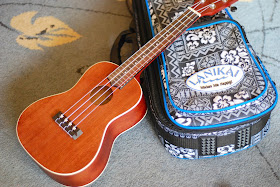
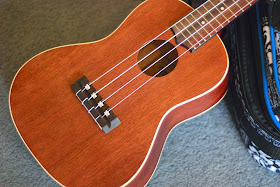
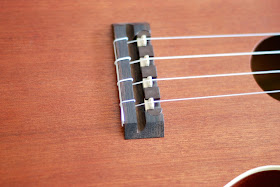
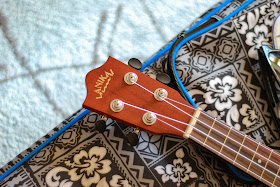
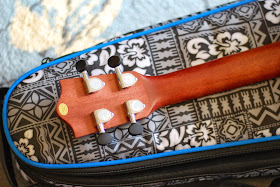
Thanks for another great review Barry. This new bridge design looks very interesting. I have their Pineapple Model LU-21P and have found it a great beginner's ukulele at very nice price.
ReplyDeleteHere's a very thorough tutorial on how to adjust the action of the TunaUkes without the use of any tools:
ReplyDeletehttp://fanguitarandukulele.wordpress.com/2014/03/25/lanikai-tuna-uke-bridge-set-up-how-to-lower-the-string-action/